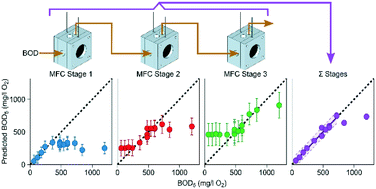Extending the dynamic range of biochemical oxygen demand sensing with multi-stage microbial fuel cells†
Abstract
Water quality sensing is a promising application for microbial fuel cells (MFCs) as the outputs have been shown to correlate with biochemical oxygen demand (BOD). Nonetheless to date, the upper limit of amperometric linear calibrations from MFC-based BOD sensors has been limited to approximately 250–340 mg l−1 BOD5, attributed to substrate saturation of the anodic biofilm. In this study, an extended detection range was obtained using an array of three MFCs linked hydraulically in series. The sum of the current density generated from each MFC in the array was calibrated against BOD5 and a linear response was obtained up to 720 mg l−1 BOD5 (1175 mg l−1 COD) with R2 of 97%. The dynamic range was double that achieved by the first MFC in the array operating individually. Average response time to reach a stable current for reliable quantification was 2.3 hours, a considerable improvement on the standard 5 day BOD test. The anodic biofilm of the sensor was dominated by Geobacter spp. and members of Porphyromonadaceae and these bacteria were likely responsible for electricity generation through syntrophy with fermenting bacteria also present in the biofilm. The dynamic range of the multi-stage MFC sensor could be increased by increasing the hydraulic retention time. The modular mode of operation demonstrated here allows the dynamic range of the sensor to be extended, permitting analysis of BOD concentrations ranging from those typical of municipal wastewater up to those found in certain industrial wastewaters. Critically, sensitive measurement of both low and high levels of organic carbon without requiring amendment or dilution could be achieved online and in real-time with this practical, low-cost MFC configuration.



 Please wait while we load your content...
Please wait while we load your content...